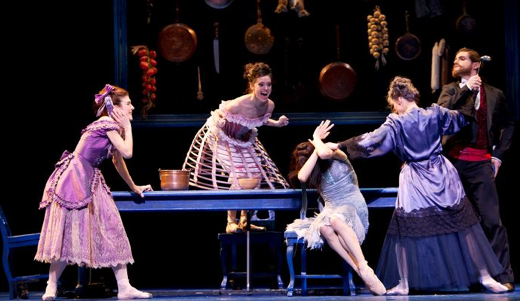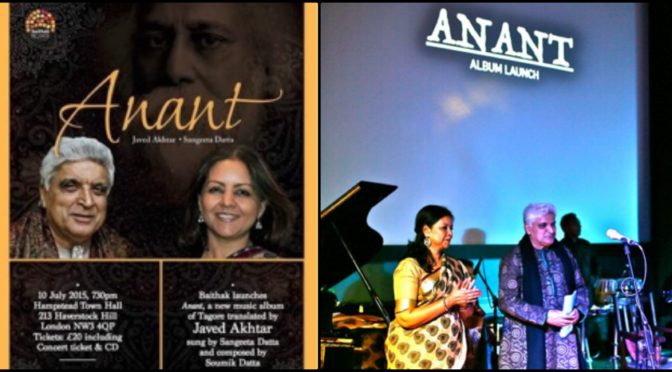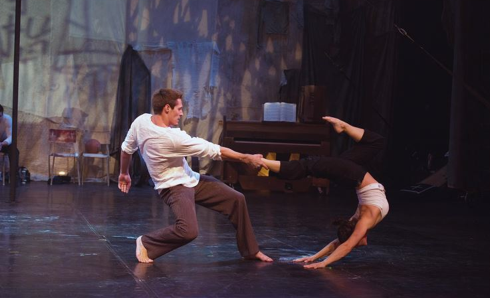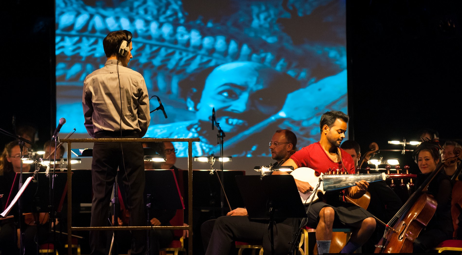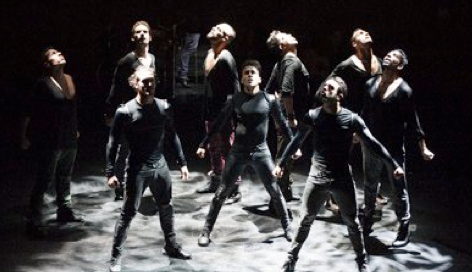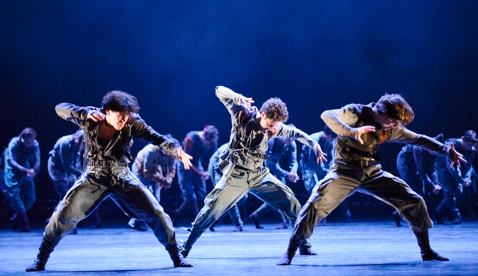There was a huge amount of buzz created in the world of dance and social media in the lead up to She Said’s opening night. This may have been fuelled by the recent heated argument regarding the lack of female choreographers at the top of the dance industry. Tamara Rojo, who as Artistic Director of the English National Ballet made this programme of dance possible, this makes the point that ‘in 20 years of being a professional dancer, she had never performed in a ballet made by a woman.’ An interesting statistic to start the evening.
The triple bill consisted of Broken Wings by Annabelle Lopez Ochoa. This narrative driven piece depicting the life of Frida Kahlo was a colourful feast for the eyes. Rojo played the character of Frida from the young, carefree teenager, and into the tragic accident that lead Kahlo to her paintings. The stage was filled with characters straight from the canvases of Kahlo’s work. Skeletons, dressed in Day of the Dead Mexican costumes, accompanied deer, birds and monkeys. These skeletons physically manipulated Kahlo throughout the piece, including through a graphic scene portraying one of Kahlo’s miscarriages. The costumes were unforgettable, expertly in harmony with Lopez Ochoa’s choreography.
M-Dao by Yabin Wang also dealt with a narrative, this time the Greek story of Medea was the subject. Medea was exquisitely played by Lauretta Summerscales. The dramatic and tragic tale was helped along with some inventive set design. The white cloth sails that draped from the top of the stage drew a gasp from the audience as it cascaded like water down onto the floor. The whole piece was very tactile and emotive. The choreography was more centered in traditional ballet, which suited the ENB cast. The atmosphere, which was poignant throughout, finished on a very haunting note.
The evening finished with the very different Fantastic Beings by Aszure Barton. The interplay between the score by Mason Batest and the choreography was akin to watching Disney’s Fantasia. The dancers were able to physically visualize every instrument, every change in tone or pitch and rhythmic interplay. The large and anonymous cast were all dressed in slick Cunningham-esque body suits and performed to a backdrop of twinkly lights. The choreography was bold, vivacious and unpredictable.
One thing was very clear from the evening, all three of these choreographers and their works were deserving of their moment on the Sadlers Wells stage. I am really hoping that more of them, as well as other female choreographers, will be seen topping theatre bills.
Review by Sara Daniels
Photo: Tamara Rojo and Irek Mukhamedov in Broken Wings by Annabelle Lopez Ochoa (c) Laurent Liotardo
Hello
Archives
Feb 02, 2017 In Upcoming EventsBy Admin Tanztheater Wuppertal Pina Bausch – Masurca Fogo at Sadler’s Wells 9 – 12 February, Thursday – Saturday at 7.30pm, Sunday at 4pm
The absurd and delightful Masurca Fogo, an international co-production with EXPO 98 Lissabon and Goethe-Institut Lissabon, takes on the subject of desire and the desperate, achingly human need for love, treated to Bausch’s tongue-firmly-in-cheek wit. Dancers fling themselves down water slides, breathe into microphones, feed watermelon to a live chicken and cram into a crowded beach hut for a party, always with “Bausch’s sharp mudlarker’s eye for social ritual” (The Guardian).
Set to a soundtrack that features a gloriously eclectic mix of k.d. lang, the Balanescu Quartet’s reinvention of German electronic band Kraftwerk, and traditional African and Portuguese music, the production is an upbeat piece of dance theatre with all of Bausch’s trademark ingenuity on display.
Renowned as the inventor of tanztheater, and widely regarded as one of the most significant influences in contemporary dance, Pina Bausch has inspired generations of audiences and artists all over the world, nurturing an ensemble of vivid imagination and grand scale. Since her death in 2009, the company has continued to tour with her choreographic works around the world. Adolphe Binder will be Intendant and Artistic Director of Tanztheater Wuppertal Pina Bausch from May 2017.
Ballet Folklorico De Mexico De Amalia Hernandez Mexico’s National Dance Company London Coliseum 22-25 July
Ballet Folklorico De Mexico brings a mesmerising presentation of colours, rhythm and rituals of Mexico. It beautifully captures the essence of the Mexican spirit-a living culture steeped with ancient history.
Established in 1952 by Amalia Hernandez Navarro from Mexico city, the company continues its work of presenting the life and spirit of the Mexican people, their beliefs, rituals and ways of life through movement, dance and music. The style has evolved over the years, and has been reworked to keep up with the times. The style traces its history to the pre-Colombian civilizations, through the Hispanic influences of the colonial era up to the Revolutionary years of the early 20th century – through the expressive form of folkloric dance.
The presentation consisted of 9 dances which came in varied shades of colour. The opening piece “Los Matachines” dance is from Northern Mexico based on a scene of war. 18 dancers wearing large head gears more like sombrero hats exude vigour and strength through physicality and extreme masculine movement.
The following dances portrayed a typical hispanic flamboyance of social dancing with gentle hip sways and shoulder shakes of women in long twirling skirts and men in colourful suits. The symbols of latin American dance – fans, scarfs and high heels propped these pieces, bearing a very subtle style which is the signature of the company. With restrained movements the dances carried an undertone of sophistication in their execution. Each choreography used a magical number multiplication technique with gradually increasing number of dancers on stage creating a beautiful effect. Frequent entrances and exits by the forty dancers and the immaculately choreographed line pattern changes took a clever turn in seemingly increasing magnitude and volume.
The Deer Dance stands out due to it’s contrast in numbers and setting. A male deer tries desperately to save himself as he is pursued by a group of hunters. A simple theme brilliantly choreographed and danced with precision. The agility and convincing imitation of the male deer in its attempt to fight the hunters magically transports the audience to the woods for a few minutes. You snap out only when the deer lies wounded on the floor.
This charming performance marks a successful celebration of the year of Mexico in the UK. The confluence of colourful and flamboyant costumes, beautiful choreography of large numbers of dancers and traditional live music make it a grand spectacle.
Reviewed by Protima Chatterjee
Dutch National Ballet Cinderella: Christopher Wheeldon London Coliseum 8-11July 2015
Christopher Wheeldon has revamped Cinderella, bringing the Ballet into the 21st Century. It is still set to Prokoviev’s score, but Wheeldon has played with the story line, keeping it more true to the Grimm Brother’s fairy tale. We have lost the fairy godmother and the pumpkin and we gain four fates and a magical tree. The stage design, set and costume have very much, a modern touch. The performance is set in three acts, meaning that this production is not a short one, however, the overall impression is one that has a magical and childlike mystic.
It was the intention and execution of the set design that captured my attention and awe. The production was very visual throughout, and I can imagine as a child watching I would have felt I had been transported into an enchanted world. The Ballet, for me, has always been quite the mesmerizing place to visit. This production captured that emotion and ran with it. The vision created at the end of Act 1 of Cinderella leaving on her carriage, was spectacular using masks, billowing sheets of material and physical theatre techniques. I can also still picture the beautiful, chandelier lighting created for the Palace ball scene, as well as the swaying chairs, hanging down from the proscenium arch, framing the stage for Act 3. All of these highlights would not look out of place in a contemporary dance piece, but in a Ballet, they were unexpected moments of joy. Why shouldn’t Ballet incorporate features of modern dance today in their productions?
There were occasional moments in the choreography that felt bulky. The grand ensemble sections of dance that should have flowed and swept across that stage, instead had floor patterns and unison actions that were hard to spot. There was no real emotive connection to the music and the corps de Ballet’s choreography, which was disappointing; this being such an important and regular feature in the more traditional Ballet productions.
There was no denying however, Anna Tsygankova and Matthew Golding’s skill and performance quality. They both executed their characters’ roles with ease and flair, perhaps the fact that they are actually a couple helped to tell the romantic story. Other notable performances go to Larissa Lezhnina for her witty performance as Cinderella’s stepmother and Remi Wörtmeyer as the Prince’s friend Benjamin.
This is definitely a show that the whole family can enjoy, children will leave amazed!
Reviewd by Sara Daniels
(Sara is a freelance dance teacher and lecturer in dance education)
Baithak launches Anant-a new music album of Tagore translated by Javed Akhtar, sung by Sangeeta Datta, music composed by Soumik Datta. Friday 10 July, Hampstead Town Hall
Poetry is essentially intranslable. Poems carry with them words which are rooted in a culture, language and history. Rabindra Nath’s Nobel prize winning “song offering” (Geetanjali) was more of a transcreation and not a translation as the poet himself modestly admitted to the limitations of transposing his deeply Indian spiritual work into a foreign language.
Bengalis have drunk deep from the bottomless fountain that is Tagore, but are very often at a loss to describe to a non bengali speaker how this superhuman’s body of work can pervade every aspect of a people’s thinking, dreaming, living, loving and dying.
Hindi is spoken by the vast majority of people in the Indian sub continent but it is perhaps safe to say that till date Tagore’s poems have not been able to capture their imagination.
Sangeeta Datta with the masterstroke of collaborating with Javed Akhtar, one of India’s most talented contemporary poet, lyricist and script writer has taken a few bold steps in the direction of opening up Tagore to a large section of the Hindi speaking population.
Anant is a music album of 8 Tagore songs transcreated into Hindi by the phenomenal Indian poet, Javed Akhtar. These are well known songs often heard in cultural programmes and preferred by leading exponents of Rabindra Sangeet and Tagore lovers.
Akhtar has done an impossible job, placing hindi words which capture very nearly the same emotion and evokes memories in most of the songs.
For instance the love lorn storm tossed spirit in ” Aji jhorer ratay tomar abhishaar” (“my dearest friend, for your tryst you have chosen this stormy night”) is rendered in Hindi as “Ghan ghor Barkha ki hai yeh Raina”
For the launch event Akhtar read his poems and talked about the process of translation. Sangeeta Datta sang with a live band including some of the musicians who feature on the album. At a point during the course of the evening when Akhtar read his lines I closed my eyes and soaked myself in the words that flowed, the music that blanket them, the melody which drifted along and vocals that preceded and followed-totally immersed in the transcendental moment that it created.
While the transcreation was beautiful, the songs were set to music compositions by Soumik Datta in his unique signature style- a rich fusion of Indian and western instruments joining together with the melodious Rabindra Sangeet renditions of Sangeeta Datta and Chiranjeeb Chakraborty into a harmonious whole
Soumik stays true to the soul of the original melody of the songs while bringing in a fresh and revitalizing perspective into his compositions which is a welcome change to the sometimes dour and doctrinaire interpretations that Rabindra Sangeet listeners are subjected to.
It is amazing how the master’s work in a different language, how the master’s melody in contemporary compositions and how the conventional songs sung with a different touch could effortlessly mingle and play to create a soundscape that is rooted and fresh. An approach that can attract younger generations to take greater interest in Tagore.
Making his music more accessible to today’s generation is arduous. The task of making Tagore available in Hindi is vast and even more challenging. Baithak has taken on this dual challenge and succeeded. We wish to see more such collaborations in the future with equally beautiful results.
Reviewed by Protima Chatterjee
Traces by The 7 Fingers The Peacock Theatre 9 June-12 July 2015
The 7 fingers from Quebec is one of the world’s most inventive contemporary circus companies. After success with its previous show Sequence 8, the company returns to the Peacock Theatre with the critically acclaimed TRACES
Performances: Tue – Sat at 7.30pm, Sat Mat at 2.30pm, Sun at 2pm & 6pm
Tickets: £15 – £38, Under 16s half price
Ticket Office: 0844 412 4322 or www.sadlerswells.com
This is a show that certainly packs a punch. In the two hour show (including an interval) you will absolutely be taken on an intense adrenaline ride. It had the audience making audible gasps, and spontaneous applause erupted after almost every segment.
The talent on display alone was enough to win me over; these 7 performers are extraordinarily gifted. They made their acrobatic accomplishments look easy and effortless. There were so many moments of excellence, it is hard to pull out highlights, however, a tender dance duet performed by Anne- Marie and Harley took the idea of contact work to a whole new level. They had the focused dynamics, they told the story of their relationship through good choreographic decisions, however they also added ‘hand to hand’ technique, which was bolder and braver than any lift work I had seen before.
The end of the first act was another breathtaking section. This piece used Chinese poles and was accompanied by the beautiful soundtrack of Radiohead’s Talk Show Host. Words and even pictures can not accurately describe the gravity defying, courageous, yet beautiful imagery that was created on stage. I almost apologised to the person sat next to me as I sat with my jaw open (literally) and uncontrollable sounds escaped my mouth. Incredible.
It was not the actions alone that stood out and made an impression. The audience were allowed to get to know the performers on stage. They spoke, had names and shared personal stories with the audience. You felt that you knew them.
This genre of modern circus seems to be very current in the dance circuit. Traces is an excellent example of how all these art forms can work in harmony together and enhance the other. I love the way Dance as an art form is constantly changing and evolving. If this signals the new chapter for the direction of dance, I am sold and for me, it is very welcome. Traces needs to be seen to be believed, and even during the interval I was contacting people to go and see it!
Reviewd by Sara Daniels
(Sara is a freelance dance teacher and lecturer in dance education)
Lost Dog presents: Paradise Lost (lies unopened beside me) Battersea Arts Centre Wednesday 27th May 2015
Tens of characters and tens of thousands of lines of poetry relayed in one hour by one man who promises to dance the complicated bits
Created, devised and performed by Ben Duke |
Based on the book by John Milton
Light and set design by Jackie Shemesh
Artistic Collaborator Raquel Meseguer
I am not going to lie. The prospect of an 80 minute dance solo based on the epic John Milton poem did not have my heart pounding in anticipation. Dance solos are hard for me to adore at the best of times, and the idea of one depicting the huge themes and grand ideas that Milton discusses throughout Paradise Lost was not a promising one. How does one even start to imagine it?
I can however, categorically state, that I was wrong to judge!
I was thoroughly impressed, entertained and engaged from beginning to end. I am not entirely convinced how Ben Duke managed to do it. The moment he entered the stage I was engaged, his casual sense of performance was intoxicating. You did not quite know whether he had started the piece or was just having a chat with the audience, but you felt safe and secure in his company. He had the audience in the palm of his hand and within 5 minutes laughter had erupted around the performance space.
Duke managed to skillfully portray the bold and significant characters of God, Lucifer, and Adam, but the most endearing and enchanting character was of Ben himself. He allowed small personal moments enter into the narrative; his vulnerability was touching and intimate.
This piece was inventive, creative and thoroughly entertaining. There were unfortunately only two nights of performance (rumor has it that this will be showing at the Edinburgh Fringe Festival in the summer) but I will be on the look out for Ben Duke and Lost Dog in the future. If Duke can make an inspiring solo from Paradise Lost then there is surely no end to his talent! One to watch!
Reviewd by Sara Daniels
(Sara is a freelance dance teacher and lecturer in dance education)
King of Ghosts Soumik Datta with London Philharmonic Orchestra 19th May-Queen Elizabeth Hall
A live film score composed by Soumik Datta,Johannes Berauer and Cormac Byrne.
Conductor: Johannes Berauer
Sarod:Soumik Datta
Bodhran and percussion: Cormac Byrne
Alchemy returned to the Southbank Centre for its sixth year, playing host to a plethora of UK and South Asian music, dance, theatre, literature, fashion, design and comedy. (15th -25th May 2015)
Tipped as one of the UK’s biggest new music talents, Soumik Datta captivated the audience of the Queen Elizabeth Hall during King of Ghosts (originally commissioned and toured by the Edinburgh Mela) with the sounds of his beautifully enchanting sarod on a rainy Tuesday night. Datta’s music sang out playfully and he was joined by members of the London Philharmonic Orchestra, percussionist Cormac Byrne and conductor Johannes Berauer. Datta composed the contemporary score, with Byrne and Berauer as co-composers, in homage to one of Oscar-winner Satyajit Ray’s classic films he watched as a boy.
The score was set to the 1969 black and white Indian arthouse film ‘Goopy Gayen Bagha Bayen’, a jovial fairy tale of two musicians (Goopy who wants to sing and Bagha who plays the dhol (drum)) banished by the King from their village who cross paths in the jungle. By chance they meet King of Ghosts, who grants them three boons (a benefit bestowed in response to a request), the first boon ‘they will get food whenever they want’; the second boon: ‘they can go anywhere they want’; and the third boon: ‘they will master the art of music and everybody will be spellbound and motionless while they sing’. The two musicians go on their way and find all three boons to come true, they chance upon a music competition to be court musicians to the King of Shundi and they hypnotise anyone who hears their sound thus winning food and shelter at the palace. The Kings long lost brother declares war on Shundi and after no solution is found the musicians volunteer to resolve the conflict themselves…
Datta’s contemporary rendition to this classical Indian film, it’s music and message has much to do with the turbulent living today. In the story the two musicians go to different countries and become an emissary of peace- a message perhaps especially resonant today. Goopi and Bagha are commoners but they follow their dreams and succeed. An aspirational triumph made possible by the sheer power of music.
Datta reaches into childhood memories and the retelling of a well known bengali folk tale
to create an enchanting music scape. He draws from the original score, from classical and folk Indian music and in collaboration with Johannes Berauer produces a high quality original work.
Listening to the sarod and blending sound of the tabor drum was enchanting. It transfixed the audience to Goopy and Bagha’s playful journey through time and space to eventually find happiness. Safe to say we all left the performance in high spirits and awe of the performers. Soumik Datta with his fresh approach to Indian classical music and appreciation of traditions does not need a boon from the king of ghosts!
Reviewed by Lauren Austen
Lauren is a music blogger, currently working in film production and talent management
Rojas and Rodriguez, Titanium The Peacock, 5-23 May
Flamenco duo Ángel Rojas and Carlos Rodríguez present the UK premiere of an unprecedented fusion between flamenco and street dance. A troop of 13 men take to the stage, dancers and musicians, fusing the rich dance heritage of flamenco with the rawness of hip hop and break dance culture. The show has won a National Dance Award in Spain and received high praise in a tour across Europe.
Titanium features a multi-talented dance cast of three flamenco dancers, three hip hop dancers and three break dancers including Elihú Vázquez; Vázquez is the nine-fold winner of the b-boy championship of Andalucía, and was part of Spain’s winning team in Battle of the Year 2005, the most important annual international b-boy competition. The dancers are accompanied by a live band of four, mixing flamenco with hip hop beats.
Titanium had me intrigued and interested from the outset. Dance styles that would not normally be said in the same sentence (hip-hop, break dance and flamenco), thrown together on stage and compelled to battle it out against the sound of live musicians. Who wouldn’t be even slightly interested?
This male-only cast of thirteen had the task of fusing these three styles together, their argument for smooth exchanges between them being that all three styles ‘were born in the streets, and when their dancers dance, they are filled with a burning need to express themselves’.
There was definitely passion observed from all three styles on stage, the flamenco dancers worked slightly better against the traditional Spanish music, and for a flamenco novice as I am, it was a thrilling display of musicality and fervor.
The b-boys were absolutely incredible, demonstrating with jaw-dropping ease the most gravity -defying actions, whilst still managing to play around with the syncopation in the music. Every time they entered the stage, they created thrill and awe.
Although the style of music did not suit all of the genres of dance on display, the live music did add to the spectacle. The musicians and dancers were in a constant battle of rhythms, their personal passion and joy was tangible.
It would have been preferable if they stayed on the stage at all times, instead they would come in and out of vision, blocked by a moving backdrop; the poor guitarist who had to take on and off a chair every time.
The use of many props was again, slightly distracting. A piece of mirrored metal, a gigantic billowing skirt, boxes as well as an elastic cord was all thrown into the mix. The dancers were of strong enough technique that these items were unnecessary and felt more like ‘fillers’ than essential to the choreography.
The audience were completely thrilled by the performance, giving the entertainers a standing ovation at the end, a very rare sight in London! I did enjoy the piece, some moments were breath- taking, others, for me, were slightly indulgent and over dramatic. Take out the props and the ‘fillers’ and you would not only have a thrilling performance, but you would also have a more powerful, insightful choreographic work.
Reviewd by Sara Daniels
(Sara is a freelance dance teacher and lecturer in dance education)
Hofesh Shechter World Premier:Untouchables Mixed Bill – The Four Temperments/Song of the Earth Royal Opera House, 27/30 March, 8/10/14 April 2015
There is something about Shechter…Even harden Ballet fans in the audience, who had not seen any previous Shechter work, had to admit that his work has its own energy that whips you up along for the ride.
I really enjoyed the juxtapositions throughout the evening, the first and most obvious being that Shechter was sandwiched between the more traditional works by Balanchine and MacMillan. I spent some of the performance sneaking looks at members of the audience trying to gauge their reaction to this unusual interruption to their normal classical narrative. I saw some nervously glancing around, but others completely enthralled by the earthy actions and thumping heartbeat.
The evening was a treat, to be honest, I am not sure there are better places to spend a Friday night!
The Four Temperaments was thoroughly enjoyable with its strong women powering across the stage; legs high, pelvis thrust forward. The awkward body shapes highlighted by the plain practice clothes as costumes. Song of the Earth, by Kenneth MacMillan was a platform to showcase the three huge talents of Carlos Acosta, Thiago Soares and Marianela Nuñez. Nuñez in particular was stunning to watch in her depiction of the role ‘Woman’. She embodied the character with such sensitive emotion and expression it was breathtaking.
However, it is Shechter’s work that made the biggest impression on me. I can’t quite put my finger on what it is about his work that I like. His use of music, the percussion in particular is intelligent as it awakens and draws in the audience. His dancers physically demonstrate this joint heartbeat; their timing is incredible, the large cast of twenty moved and breathed as one. At times they looked like a shoal of fish, twisting and moving around the stage in complete sync with one another. Then suddenly, this group would disperse and complete contrasting actions would be juxtaposed across the stage. The transitions were so smooth that it felt like the dancers were playing tricks on the audience.
There was a lot of repetition for just thirty minutes of choreography, but the ‘dancing like no one is watching’, lack of inhibitions and dancing from the inside out – the very Shechter –esque movement vocabulary that can be seen throughout his work never fail to draw you in and make you smile. Untouchable was no different.
Reviewd by Sara Daniels
(Sara is a freelance dance teacher and lecturer in dance education)



